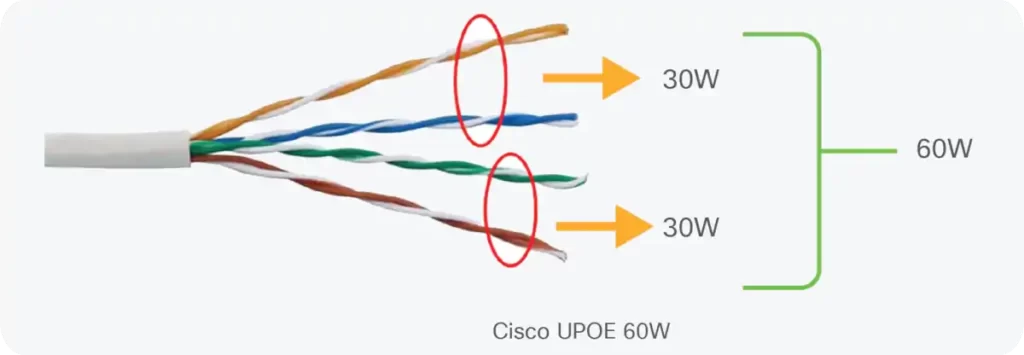After 802.3at made it possible to provide roughly 30 watts over two pairs of wires, it was a relatively straightforward process to extend the standard to provide power over four pairs simultaneously. This approach provides roughly 60 watts of power, by implementing two sets of 802.3at-compliant electronics at each end of the link and powering all four wire pairs at the same time.

When the new IEEE four-pair PoE extension that is currently under development becomes adopted as part of the standard, it will become possible to provide higher power using technology that will interoperate between multiple vendors. Until that happens, various vendors have provided their own solutions, several of which are described next.
Cisco UPoE
Cisco Systems is one major vendor providing four-pair PoE power, which it terms Universal Power over Ethernet (UPoE). Cisco has also extended the LLDP-based power negotiation protocol to allow mutual identification and dynamic power budgeting up to 60 watts. Cisco switches can be configured to statically set the port power budget to enable support for devices that do not know how to deal with Cisco’s UPoE extensions.
Microsemi EEPoE
Microsemi is a company that provides midspan PSEs for PoE. It has also extended the 802.3at standard to provide power over four pairs of cables, in an approach that it calls Energy Efficient Power over Ethernet (EEPoE). Microsemi points out that midspan PSEs can be upgraded without having to change your switching hardware, allowing an innovation like EEPoE to be implemented at a lower cost (assuming you are already using midspan technology).
The advantages of this include more flexible power management than that provided by some PoE switches, as well as improved integrated circuits for PoE ports that minimize the power consumed by the PoE detection process, among other things. The vendor notes that four-pair powering helps reduce power losses over the copper cabling, further improving energy efficiency.
Power over HDBaseT (POH)
The HDBaseT specifications are not a part of the IEEE standard. Instead, they have been developed by the HDBaseT Alliance, which was formed to develop technology for use in home entertainment systems—hence the use of “high definition” (HD) in the specification name. The HDBaseT system operates over Category 5e/6 cabling to provide up to 10.2 Gb/s of uncompressed video and audio signals, 100BASE-T Ethernet, control signals, and power on the same cable.
To learn more about Power over Ethernet you should also read these articles:
- PoE Main Article
- PoE Device Roles and Type Parameters
- Power over Ethernet Operations – How does PoE work?
- PoE and Cable Pairs
- Power over Ethernet Port Management
